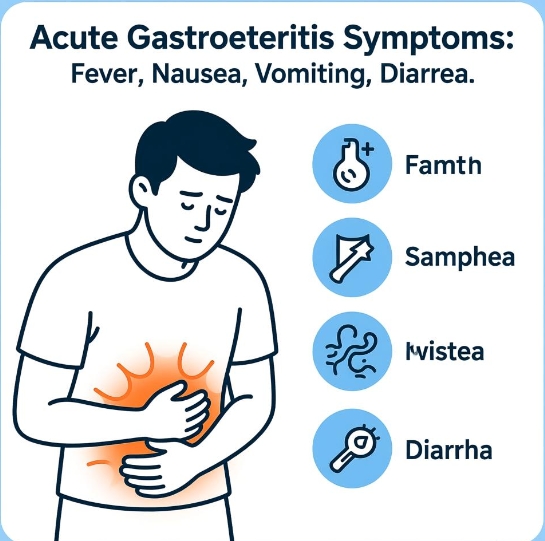Acute gastroenteritis is a sudden inflammation of the stomach and small intestine, most often infectious but sometimes toxin-mediated. It peaks within hours to a few days, resolves within a week in immunocompetent hosts, and ranges from mild discomfort to rapidly dehydrating illness. Recognizing its varied faces guides fluid replacement, diet adjustment, and decisions on medical review.
- Cardinal gastrointestinal symptoms
- Nausea: an uneasy urge to vomit, sometimes accompanied by hypersalivation.
- Vomiting: initially gastric contents, later bile-stained fluid; repeated cycles every 30–60 min suggest viral or food-borne toxin origin.
- Diarrhea: watery, occasionally rice-water or bloody; frequency >3 times per day, volume >200 g, lasting <14 days defines the acute window.
- Cramping abdominal pain: periumbilical or upper-mid, colicky waves that ease briefly after stool or gas passage.
- Hyperactive bowel sounds: audible gurgling or splashing without stethoscope during severe phases.
- Systemic and dehydration clues
- Low-grade fever 37.5–38.5 °C common in viral and bacterial cases; >39 °C raises suspicion for invasive pathogens.
- Malaise, myalgia, headache: part of systemic inflammatory response.
- Thirst, dry lips, reduced urine output: early dehydration.
- Sunken eyes, delayed skin turgor (>2 s), orthostatic dizziness: moderate to severe fluid loss.
- Irritability or lethargy in infants, absence of tears, and sunken anterior fontanel mark critical deficit.
- Variant presentations by pathogen group
- Viral (rotavirus, norovirus): vomiting precedes diarrhea, fever mild, symptoms resolve in 3–5 days; outbreaks in schools or cruise ships.
- Pre-formed toxin (Staphylococcus aureus, Bacillus cereus): sudden onset within 6 h of food, intense vomiting, short duration 12–24 h.
- Invasive bacteria (Salmonella, Shigella, Campylobacter): fever >38.5 °C, bloody stools, tenesmus, leukocytes on stool smear.
- Cholera-like: profuse painless “rice-water” stools, rapid dehydration, risk of hypovolemic shock within hours.
- Red-flag combinations demanding urgent care
Persistent vomiting preventing oral intake, bloody diarrhea with hemodynamic changes, high fever >39 °C with altered consciousness, severe abdominal rigidity or localized rebound, and oliguria despite rehydration efforts.
Summary table
| Symptom complex | Typical cause | Home-care threshold |
|---|---|---|
| Watery diarrhea, mild fever | Viral | ORS 200 mL after each stool, solids when tolerated |
| Rice-water stools, no fever | Cholera | Seek care immediately; start ORS en route |
| Bloody stools, high fever | Invasive bacteria | Medical review for stool culture ± antibiotics |
| Vomiting every 30 min | Toxin | Small ice-chip sips; if >8 h no keep-down, visit ED |
| Sunken eyes, dizzy stand | Dehydration | If unable to drink or urine dark/scant, go to hospital |
